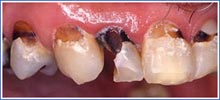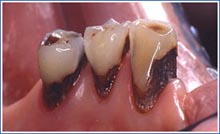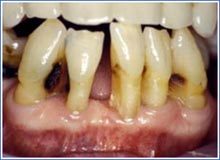Caries: Risk Factors and Prevention
Caries can occur on the crown of the tooth (coronal caries) or the root surface of the tooth (root caries). Over 50% of the elder population who have natural teeth are affected by caries. Individuals over 60 years of age are twice as likely to experience root caries as those 30 years of age.
Risk Factors
- High oral bacterial counts
- Frequent consumption of sugar-containing foods
- Inadequate fluoride exposure
- Low socioeconomic status
- Xerostomia related to medications or disease
- Physical disabilities and dementia
- Brushing and other oral hygiene activities become more difficult
- Existing restorations or appliances
- Recurrent caries common at site of existing restorations
Prevention
- Daily oral hygiene that includes fluoride toothpaste and flossing
- Regular professional dental care
- Fluoride rinses, gels or varnishes for high-risk patients, especially institutionalized elderly:
- Fluoride rinse: Phos – Flur 0.044% (sodium fluoride and phosphate fluoride rinse) 10mL once daily after brushing
- Fluoride gel: Gel Kam (0.4% stannous fluoride gel) cover toothbrush with gel and brush once daily
Extensive Caries

Root Caries

Root Caries

References
Demirci M, Tuncer S, Yuceokur AA. Prevalence of caries on individual tooth surfaces and its distribution by age and gender in university clinic patients. Eur J Dent. 2010;4(3):270-279.
Rapp L, Maret D, Diemer, F et al. Dental Caries in Geriatric Dentistry: An Update for Clinicians. International Journal of Oral and Dental Health. 2019; 5(1).
Warren JJ, Cowen HJ, Watkins CM, Hands JS, Dental caries prevalence and dental care utilization among the very old. J Am Dent Assoc 2000; 131:1571-79.
Tan HP et al. A Randomized Trial on Root Caries Prevention in Elders. JDR 2010; 89(10): 1086-1090.